Food writer. Cooking instructor. Recipe developer. Cookbook writer. These are just a few titles that powerhouse Sandra A. Guiterrez has under her belt. The former editor has published four cookbooks, each focusing on a different aspects of Latin cuisine. Most recently, her 2011 publication, The New Southern-Latino Table, was recognized by the Smithsonian Museum as a major represenation of Latino culture.
We spoke with Gutierrez about her cookbook, southern-Latino fusion and more. Here’s what she had to say.
Tell us about cooking Latin American food in the Southern U.S. Where does the mashup originate?
I had already lived a while in Northern Carolina when I discovered a new culinary movement in 1996 where Latin American and Southern foods were being combined at the table. I called it “The New Southern-Latino movement”, which is when ingredients from both cultures come together seamlessly to produce dishes that Southerners and Latinos both recognize but with a twist. In this movement, tamales are made with grits instead of masa; barbecue sauces are peppered with chipotle chiles; pico de gallo is made with peaches; ice cream is made out of corn and topped with pralines; and hushpuppies are sweetened with sugar and cinnamon, just like churros. These are just some of the recipes that are being born in this new branch of Southern regional cuisine, which is greatly influenced by the wave of Latino immigrants that descended in the territory starting in the 1990’s. [pagebreak]
What’s the correlation between your upbringing and your cooking today?
I believe that by the most part, everyone’s food is influenced by what we ate growing up. My experience is no different. I tend to love flavors reminiscent of the foods of Guatemala, where I grew up: citrus salads with crunchy pumpkin seeds and spicy chile powders; rich stews of meats and potatoes, thickened with nuts and tomato sauces; bean dishes; and very sweet cakes and bread puddings. However, my food is also influenced greatly by the cuisine of the place where I’ve lived the longest: the American South. North Carolina has fed my appetite for seafood chowders, smoked pork, fried okra, comeback sauce, and cobblers. Luckily for me, the intersection between both culinary cultures is wide and includes delicacies like pork rinds, pies, pickled vegetables, sweet potato concoctions, and corn everything! Therefore, my palate always feels at home.
Tell us about your work with the Smithsonian.
In 2015, the Smithsonian approached me to collaborate with them on a new exhibit that depicts the Latin experience in 4 large cities in the American South, called “Gateways/Portales.” This exhibit details the contributions that Latinos in Baltimore, DC, Raleigh/Durham, and Charlotte have done in their communities, that include the arts, social justice, media, festivals, music, and foodways. They recognized the importance of my discovery of the New Southern-Latino. Given that I also wrote The New Southern-Latino Table, my book on the subject matter, they’ve included it (as well as other items from my kitchen that represent this melding of cultures), as well as a video with my oral history contribution in this beautiful exhibit, which is running at the Smithsonian Anacostia Community Museum until August 6, 2017. The exhibit is slated to travel throughout the United States in 2018. I will be signing books and doing a cooking demo at the Smithsonian Museum of American History (where Julia Child’s kitchen is) on June 17, 2017, from 2-4pm. [pagebreak]
Which recipes, in your opinion, best represent both cuisines?
The Chilled Avocado Soup with Crab Salad Nacho is one that melds both cultures beautifully. Avocado soups are found in many Latin American countries such as Mexico, Guatemala, and Brazil. However, this one is made with buttermilk, which is a classic southern ingredient; the crab salad is quintessentially southern but is similar to a ceviche and the fried tortilla is recognized throughout Mexico and Central America. Another recipe that combines both cultures beautifully is the Peach Salsa, which is my riff on Pico de Gallo. Fruit salsas abound in Latin America, but we don’t eat them with chips; rather we use them to drape over fish and grilled seafood dishes or as a topping for ice cream. The peach is the South’s favorite summer fruit, and since the tomato is also a fruit, it made sense to substitute one for the other in this recipe. It goes as well over ice cream as it does with chips. As rare as this recipe was in the 1990’s it is now commonplace today, as this movement continues to expand.
Apart from recipes, what other tips does the book offer?
Given that I am a cooking teacher at heart, I’ve included all sorts of tips for my recipes, such as how to cut a mango, how and when to freeze certain ingredients or recipes, and what to make ahead. I’ve also included information on how to shop in a Latin store and how to find the best ingredients. I love to tell a good story and you’ll find them all over my book, from how potluck dinners originated, to why sugar is so important both to southerners and Latino cooks alike.


![Making Mealtime Matter with La Familia: Easy Sofrito [Video]](https://thelatinkitchen.com/wp-content/uploads/2015/10/sofrito-shutterstock__0-500x383.jpg)
![Easy Latin Smoothies: Goji Berry Smoothie [Video]](https://thelatinkitchen.com/wp-content/uploads/2015/12/goji_berry-shutterstock_-500x383.jpg)
















![Fun and Fast Recipes: Fiesta Cabbage Salad [Video]](https://thelatinkitchen.com/wp-content/uploads/2015/11/fiesta_cabbage_slaw-shutterstock_-500x383.jpg)









